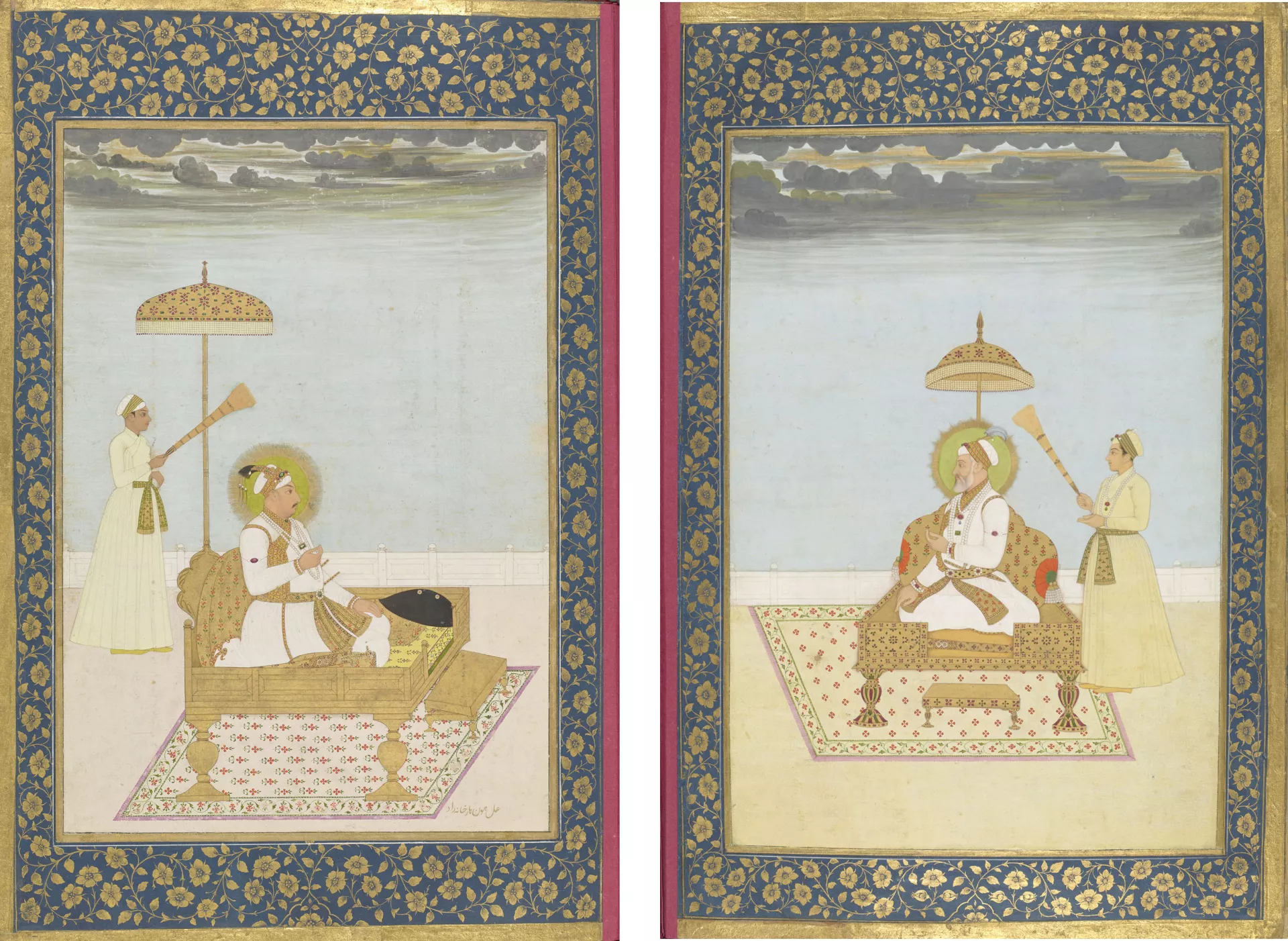
Eastern Encounters
Drawn from the Royal Library's collection of South Asian books and manuscripts
The Mughal Emperor Muhammad Shah facing his grandfather Emperor Bahadur Shah
Muhammad Shah portrait ascribed to Puran Nath, known as Hunhar II
Mughal, <i>c</i>.1740–50 Fols 28v and 29r from an eighteenth-century Mughal album (see cat. no. 38) | Paintings in opaque watercolour including gold metallic pigment and decorative incising on paper; set into margins of gold metallic paint on dark blue paper, edged with gold paper | 28v: 42.3 × 27.9 cm (folio); 32.0 × 22.0 cm (image); 29r: 42.4 × 27.8 cm (folio); 31.3 × 21.6 cm (image) | RCINS 1005068.ad and 1005068.ae
In a double-page portrait reminiscent of the frontispiece of the Royal Collection’s Padshahnama manuscript (see cat. no. 28), Muhammad Shah (r. 1719–48) seated on a golden throne (left) faces a posthumous image of his grandfather, Bahadur Shah (r. 1707–12).[149] In 1719, Muhammad Shah’s cousin, Emperor Farrukh-Siyar (r. 1713–19), was murdered by the formidable Sayyid brothers, two ministers in control of Delhi politics during the second decade of the eighteenth century, who then crowned the 19-year-old inexperienced prince as Emperor. As evident in this portrait pairing, the new Emperor, Bahadur Shah’s grandson through his youngest son, considered himself the true successor of Mughal imperial power following decades of disarray.
Even after the downfall of the Sayyid brothers within the first two years of his reign, Muhammad Shah largely delegated leadership to his viziers under whom the empire further disintegrated. The Marathas advanced northwards from the Deccan and the Iranian warlord Nadir Shah (who had usurped the Safavid rulers of Iran) invaded Kabul and Lahore before defeating the Mughal Emperor’s forces at the Battle of Karnal in 1739. Muhammad Shah ordered the Governor of Delhi to hand over the keys of the Red Fort and its treasuries to the representative of Nadir Shah who marched triumphantly into the city two weeks later.[150] Within days of the occupation, Delhi’s inhabitants rebelled against the presence of Iranian soldiers and riots broke out in which 3,000 Iranians were supposedly killed. In riposte, the furious Nadir Shah ordered a general massacre in which over 20,000 Delhi inhabitants were murdered. The mansions of nobles were set on fire and the survivors then forced to give up a large portion of their wealth to the Iranian invader.
During his two months in the Mughal capital, Nadir Shah lived as Emperor with Muhammad Shah as his political prisoner. His desire was not however to seize control of the Mughal Empire, only to appropriate its northern territories and what remained of its wealth. During a durbar ceremony on 1 May 1739, he proclaimed Muhammad Shah Emperor and presented gifts to the Mughal nobles. In return, Muhammad Shah surrendered to him the Mughal provinces in Central Asia and Afghanistan. On leaving the city, Nadir Shah took with him innumerable treasures. The booty included ten golden thrones, imperial jewels including the famous Timur Ruby (RCIN 100017), weapons, textiles, manuscripts and albums of paintings, as well as hundreds of elephants, horses and human spoils, including artists and artisans.[151] Nadir Shah stripped Delhi of its cash reserves, leaving the Mughal economy crippled.
Muhammad Shah is depicted in his mid-thirties when he wore a short moustache and appeared at his most imposing.[152] Although the Emperor lived for another eight years after the invasion, he suffered severely from diphtheria, intensified by the use of opium, culminating in an attack of paralysis which left him an emaciated shadow of his former self.[153] It is possible, however, that this portrait was painted after the Iranian invasion, when his artists consciously depicted him in a younger, more flattering light. The same portrait of Bahadur Shah appears in reverse in another contemporary painting in which he presents a turban ornament to a particularly youthful-looking Muhammad Shah.[154]
The portrait of Muhammad Shah is ascribed to the artist Hunhar, whose real name is known to have been Puran Nath.[155] He was the brother of another imperial artist, Nidha Mal, and in the inscription is termed khana-zad, meaning ‘born into the royal household’, suggesting that their father too was a royal artist. The flat, reductive style is typical of Mughal paintings of the first half of the eighteenth century. After Muhammad Shah’s death in 1748, many of his court artists left Delhi; among them was Puran Nath, who in 1758–9 travelled to Murshidabad in Bengal in the service of Prince Ali Gauhar (the future Emperor Shah Alam II) and later migrated to Awadh.[156] Other artists similarly migrated to Awadh, Bengal, Rajasthan and the Punjab, where they had considerable impact on the development of regional painting styles.
amal-e hun har khana-zad / work of Hunhar born into the royal household
[149] The album also includes an equestrian portrait of Bahadur Shah c.1707.
[150] For Nadir Shah in Delhi see Malik 2006, pp. 153–70 and Irvine 1922, vol. II, pp. 361–79.
[151] Malik 2006, p. 169. Nadir Shah was assassinated eight years later (1747) and much of the Mughal booty dispersed.
[152] McInerney 2002, pp. 17-18.
[153] Iqbalnama, note on page 397 suggests Muhammad Shah was diagnosed with diphtheria on 9 March 1743. See also Malik 2006, p. 370.
[154] See San Diego Museum of Art, 1990.368.
[155] A copy of this painting in reverse is in the Bibliothèque Nationale de France, Paris, Gentil Album, Réserve OD-43 PET FOL, fol. 27. See Hurel 2010, p. 102, cat. no. 199.
[156] For Puran Nath see Roy 2012, p. 22 and McInerney 2002, p. 29. For discussion of his later career see Losty and Roy 2012, p. 151.








